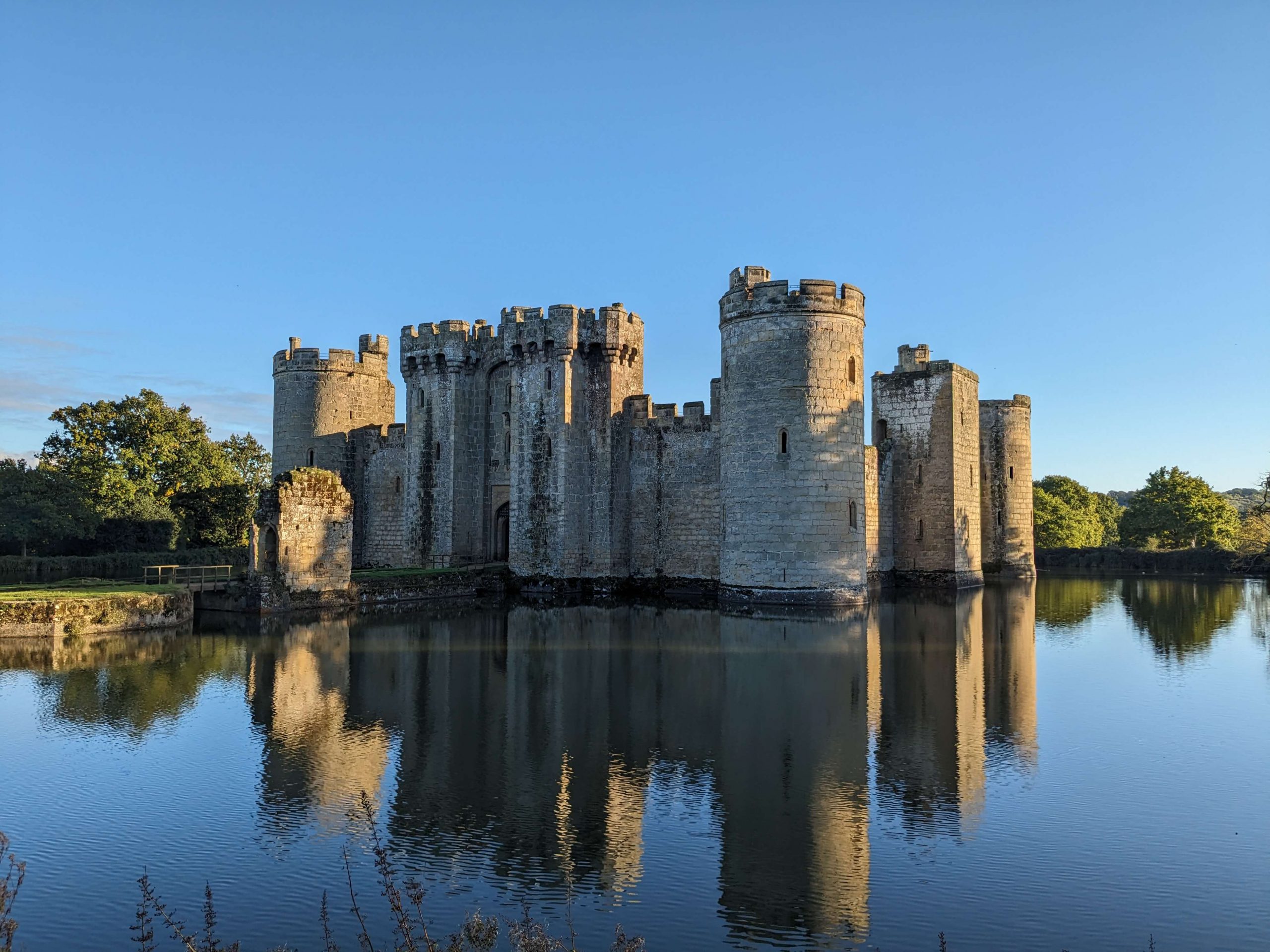Bodiam Castle is undeniably one of the most picturesque and iconic castles, frequently featured on greeting cards and chocolate boxes worldwide. This late medieval fortress was built in 1385 by the ambitious knight Sir Edward Dallingridge. Its construction unfolded during the tumultuous era of the Hundred Years’ War, a time when England harboured deep concerns about the looming threat of a French invasion.
| Built | 14th Century |
| Type | Moated Castle |
| Condition | Ruinous – Major Stonework Intact |
| Ownership | National Trust |
| Access | Public – Admission Fee |
| Postcode | TN32 5UA |
Click here to watch our video exploring Bodiam Castle and discover its history
While the castle’s appearance certainly suggests a formidable defensive structure, historians debate whether it was primarily built for defence or designed as the ultimate country manor. What is clear, however, is that Bodiam Castle exudes the image of a perfect fairytale castle, capturing the imagination with its enchanting and storybook-like beauty.
Long before Bodiam Castle ever existed, a small saxon manor house was situated on the lands. Following the Norman conquest of 1066, these lands passed to the Bodeham family. The story of the castle itself begins in the late 14th century with Sir Edward Dallingridge.
Sir Edward Dallingridge, being the younger son of Roger Dallingridge, did not stand to inherit his father’s wealth. Faced with this circumstance, he embarked on a journey to forge his own fortunes, a quest in which he succeeded admirably. In 1367, Edward travelled to France to fight in the Hundred Years’s War (a war between England and France over succession to the French throne), he fought successfully and brutally, accumulating a vast wealth from pillaging and ransoming wealthy French prisoners.
Edward returned to England in 1377, and in 1378 he married Elizabeth Wardieu, heiress of the Bodiam lands. King Richard II bestowed considerable honours upon Edward Dallingridge, appointing him Knight of the Shire of Sussex between 1379 and 1388. Additionally, in 1392, he was appointed Warden of London, elevating him to a position of great influence and making him one of the most prominent nobles in England during that era.
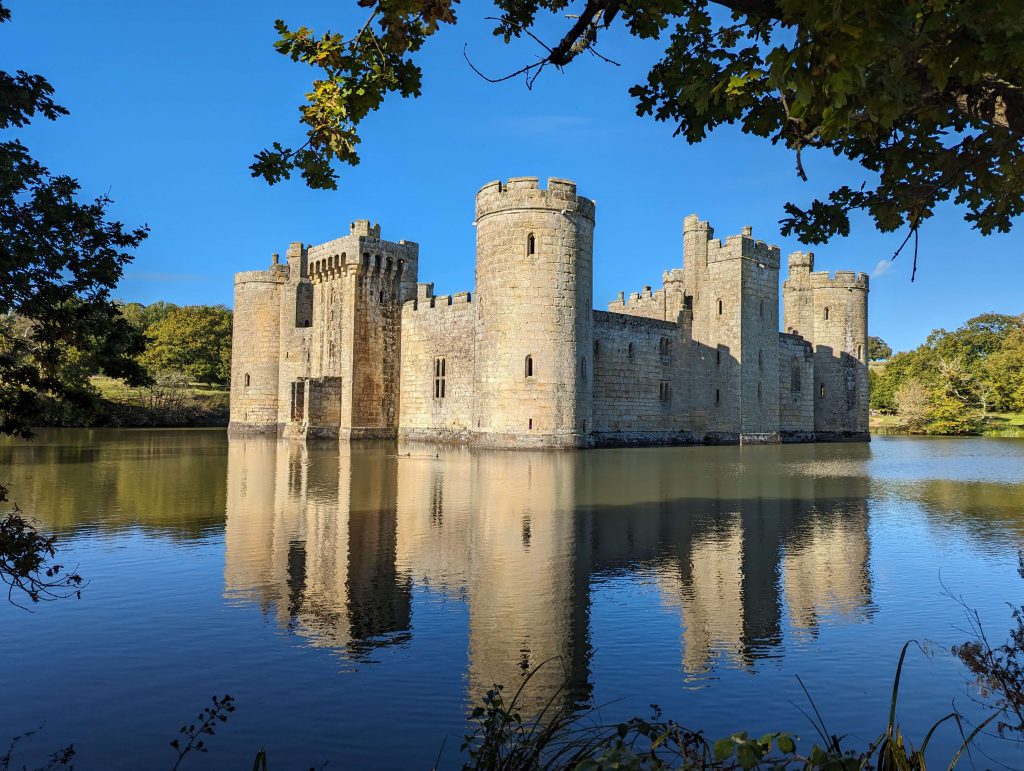
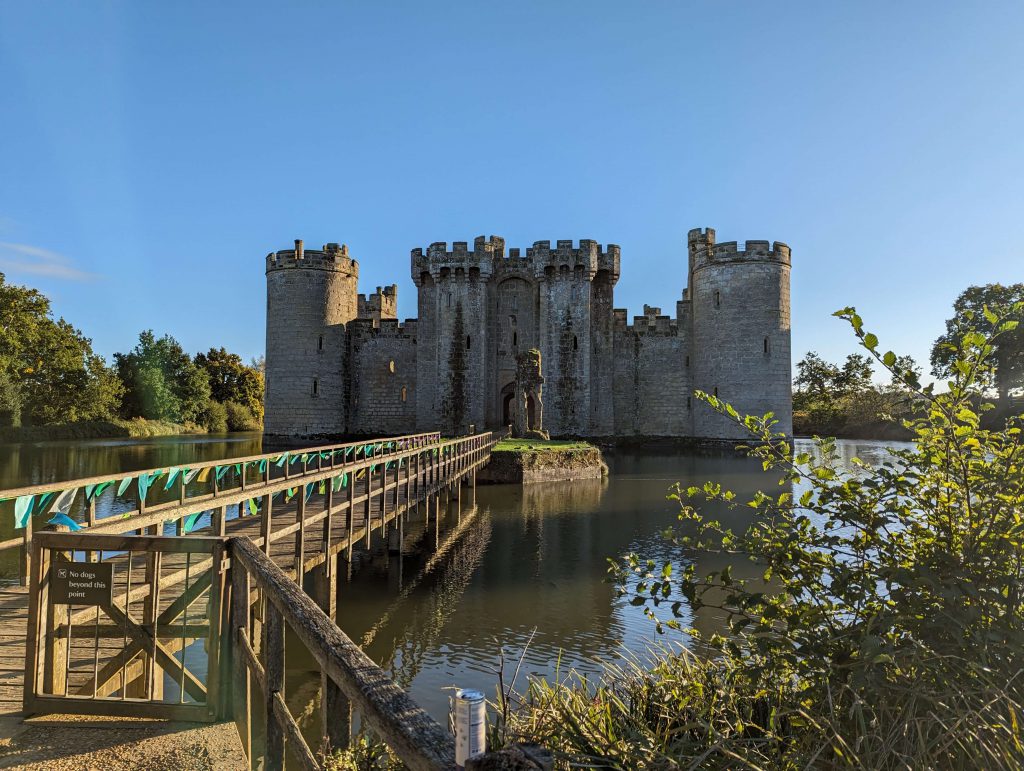
Edward Dallingridge’s ascent in status was not without challenges. In 1372, John of Gaunt, the third surviving son of King Edward III, was granted lands in Sussex. Dallingridge and other landowners in Sussex, fueled by resentment, launched a concerted effort to exert pressure on John of Gaunt. The tensions escalated to the point where Gaunt took legal action, filing a lawsuit against Dallingridge in an attempt to restrain him from interference.
Dallingridge’s conduct in court, where he defended himself, was marked by violence and unruliness, providing insight into his personality. Twice during the proceedings, he dramatically threw down the gauntlet in a bold and confrontational manner. This behaviour offers a glimpse into the assertive and combative nature of Dalyngrigge.
Dallingridge, unfortunately, lost the lawsuit and received an order to be ‘kept in custody’ until a £1000 fine was fully paid. Fortunately for Dallingridge, he had an influential patron, the 11th Earl of Arundel, who successfully intervened on his behalf with the King. As a result, Dallingridge swiftly returned to parliament without ever settling the fine.
In the 1380s, the Hundred Years’ War between England and France continued with renewed hostilities. In light of the persistent threat, the English Parliament sanctioned the allocation of funds to strengthen fortifications along the southern coast of England. This strategic move aimed to enhance the country’s defences against potential French invasions during this tumultuous period. In 1385 a fleet of 1,200 ships gathered on the French side of the English channel, it looked as though a French invasion was imminent, that same year Edward was granted a licence to crenelate (fortify) his manor house. Edward’s estate at Bodiam was situated in the valley of the River Rother, which, during that period, was sufficiently wide and deep to accommodate sizable ships, allowing them to sail as far as Bodiam.
Rather than fortify his current manor house, Edward built a magnificent new castle from scratch. Edwards castle was built to a simple rectangular plan with four circular ‘drum’ corner towers reaching 60ft (18m) high. The towers were linked by a curtain wall two storeys high, in the northern wall a vast twin-towered three storey high gatehouse stood but there was another entrance to the castle through the postern tower in the south wall, although this no longer exists. A square tower was also situated along the west and east walls.
The castle was strategically constructed on marshland, and a deliberate flooding of the area was executed to create a comprehensive moat that entirely envelops the castle. This design not only added to the fortress’s defensive capabilities but also contributed to its imposing and picturesque appearance. Anyone thinking of attacking the gatehouse would have had quite a challenge. They would have had to cross a wooden bridge to a small island known as the ‘Octagon’, they would then have to get over a drawbridge which led to a barbican (now demolished) and then get across another drawbridge before they even reached the gatehouse.
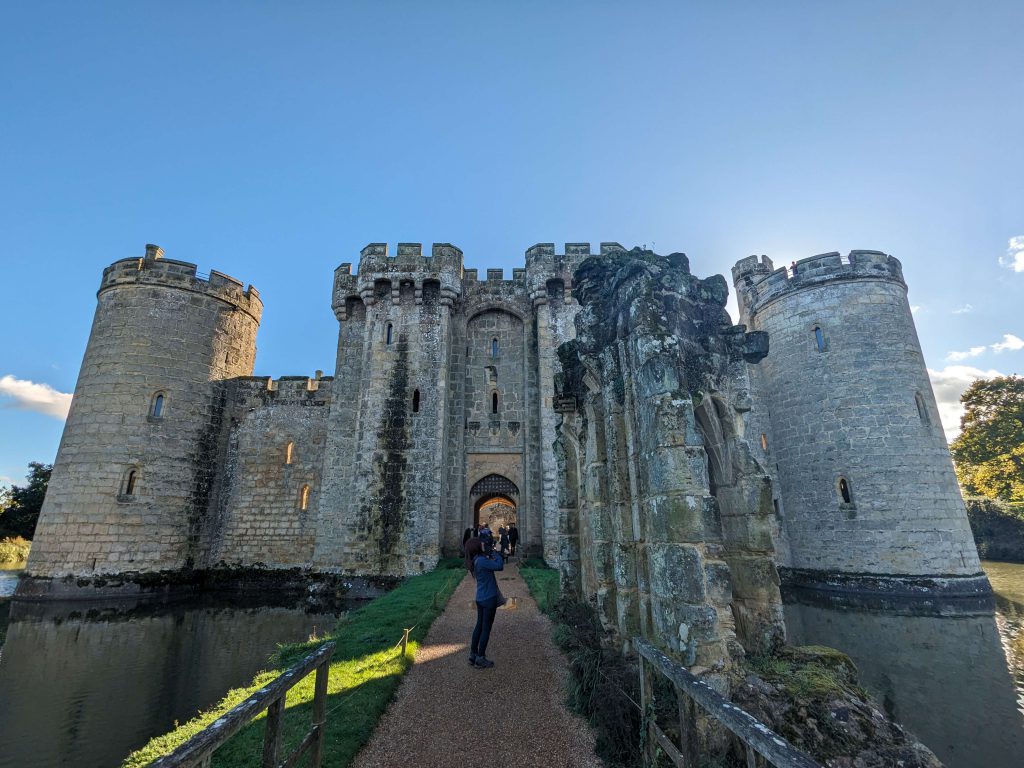

The gatehouse of the castle was a formidable structure, equipped with three portcullises (although only one remains today), gun-holes, and murder-holes. These features served both defensive and offensive purposes, allowing defenders to thwart and repel intruders by various means, including pouring down materials through the murder-holes on anyone who managed to breach that far into the castle.
Within the castle walls, there was no central keep; instead, all of the castle’s structures were built along the curtain walls. This architectural layout contributed to the castle’s unique design.
While Bodiam Castle’s defensive features are prominent, historians hold conflicting views regarding its primary purpose. Some argue that the castle was constructed primarily for defensive reasons, given the tumultuous context of the Hundred Years’ War. However, an alternative perspective suggests that Bodiam served as a luxury country manor, showcasing Sir Edward Dallingridge’s elevated status and providing a symbol of prestige and wealth. The dual nature of the castle, with its defensive capabilities and opulent design, makes it a subject of historical debate and interpretation.
Buildings within the castle walls included essential facilities such as the great hall, chapel, the lord’s private chambers, kitchens, pantry, and buttery. Notably, Edward Dallingridge’s private hall and chambers were strategically situated, allowing him to have a view of the castle chapel’s altar and attend worship while maintaining a degree of privacy from the castle’s garrison.
In later restoration efforts, it was revealed that Bodiam Castle boasted an impressive 33 fireplaces and 28 lavatories. The lavatories were designed in a manner that emptied directly into the moat. This intriguing historical detail implies that the serene moat we admire today served a less idyllic function in medieval times, essentially functioning as an open sewer system for the castle.
Bodiam Castle is noteworthy for its large windows, a departure from the typically dark and sombre atmosphere of most medieval castles. Although these windows allowed for more natural light, creating a brighter interior, they did come at a cost to the castle’s defensive capabilities. The larger openings made it more vulnerable to potential attackers.

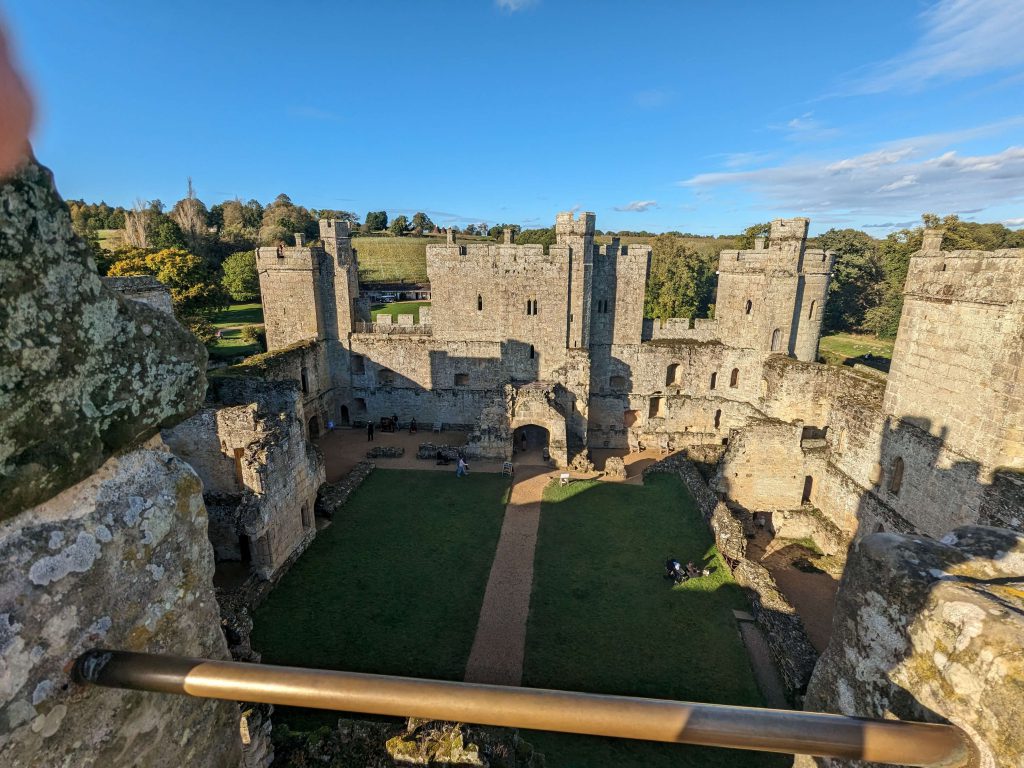
The exact date of completion of Bodiam is unknown, but it is suggested to have been finished by 1392. Regrettably, Sir Edward Dallingridge did not have much time to enjoy his splendid new home, as he passed away by 1395.
Bodiam Castle passed to Edward’s son, John Dallingridge, who like his father enjoyed the favour of the king. Upon John’s passing in 1408, without any heirs, Bodiam Castle transitioned through various members of the Dallingridge family. Phillippe Dallingridge married Sir Thomas Lewknor and their son, Sir Roger Lewknor eventually inherited Bodiam. Consequently, the castle passed into the hands of the Lewknor family.
In 1455, the War of the Roses began and Sir Thomas Lewknor, son of Sir Roger, sided with the House of Lancaster. However, when Richard from the House of York ascended to the throne as Richard III in 1483, Thomas faced accusations of treason and of raising men-at-arms in southeastern England. In November 1483, Thomas’s own uncle and Thomas Howard, the Earl of Surrey, were granted permission to gather troops and potentially lay siege to Bodiam Castle. Records do not confirm whether the siege was executed but it is believed that Thomas surrendered his castle without a struggle. Bodiam was confiscated and Nicholas Rigby was made constable of the castle.
The tides turned in the War of the Roses, and in 1485, Henry VII of the House of Lancaster was crowned King of England. With Henry’s ascension, Bodiam was returned to the Lewknor family. Although we know the castle was back in the hands of the Lewknor family there is very little to indicate how the castle was used over this period.
During the onset of the English Civil War in 1642, Bodiam Castle was owned by the royalist John Tufton, 2nd Earl of Thanet. Engaging in hostilities, John led an attack on Lewes and participated in the battle at Haywards Heath, which resulted in a victory for Parliamentary forces. As a consequence of his involvement, Parliament imposed severe penalties on John, confiscating his lands and imposing hefty fines. To meet the financial obligations imposed by Parliament, John was forced to sell Bodiam Castle in 1644. The new owner, Nathaniel Powell, was a Parliamentarian.
After the English Civil War, a practice known as “slighting” was common, involving the deliberate destruction of castles to prevent their military use. Despite being owned by a Parliamentarian, Bodiam Castle did not escape this fate. Following the war, the barbican, bridges, and buildings within the castle were intentionally destroyed, contributing to the broader effort to neutralise the military capabilities of castles across the country.


In 1722, Bodiam Castle was purchased by Sir Thomas Webster. For over a century, the castle and its surrounding estate stayed in the possession of the Webster family. During this period, the site began to attract attention as an early form of a tourist attraction, thanks to its historical ties to the medieval era. The first illustrations and depictions of Bodiam Castle emerged in the mid-18th century, portraying it as a picturesque ruin adorned with ivy.
In 1829, John ‘Mad Jack’ Fuller acquired the Bodiam Castle estate for £3,000 (equivalent to £280,000 today). Commencing some restoration efforts on the castle, it is believed that Fuller bought the castle to prevent the Webster family from dismantling it entirely for the reuse of its stone. Later, in 1849, George Cubitt purchased the castle, furthering the restoration work. Cubitt conducted the first detailed survey of Bodiam Castle in 1864.
In 1916, Lord Curzon, who had been actively seeking to acquire Bodiam Castle, finally purchased the estate. Immediately upon ownership, Curzon initiated a comprehensive program of investigation and restoration. He undertook the drainage of the moat, revealing the original footings of the bridges and uncovering numerous artefacts. Within the castle, stonework underwent repairs, and the floors were levelled.
Upon Lord Curzon’s passing in 1925, he bequeathed Bodiam Castle to the National Trust through his will. This generous gesture ensured that the National Trust could carry on the work of restoration and preservation for the captivating and historically significant castle.
Today Bodiam Castle is still looked after and preserved by the National Trust and run as a tourist attraction for the public to visit. If you are a Monty Python fan then you might also recognise the castle from the famous 1975 film ‘Monty Python and the Holy Grail’.
Click below to explore Bodiam Castle with us

